K A Story of Units® Part–Part–Total
TEACH ▸ Module 1 ▸ Counting and Cardinality

What does this painting have to do with math?
Piet Mondrian reduced his subjects to colorful geometric shapes. In this painting, bold, black horizontal and vertical lines frame the colorful squares and rectangles in red, black, yellow, and more. Do any of the shapes seem similar?
Do you notice that the smaller shapes are added together to create bigger shapes? How many shapes do you see in total?
On the cover
Composition with Large Red Plane, Yellow, Black, Gray and Blue, 1921
Piet Mondrian, Dutch, 1872–1944
Oil on canvas
Kunstmuseum Den Haag, The Hague, Netherlands
Piet Mondrian (1872–1944), Composition with Large Red Plane, Yellow, Black, Gray and Blue, 1921. Oil on canvas. Kunstmuseum Den Haag, The Hague, Netherlands. Image copyright © Kunstmuseum Den Haag. Image credit: Bridgeman Images

Great Minds® is the creator of Eureka Math® , Wit & Wisdom® , Alexandria Plan™, and PhD Science®
Published by Great Minds PBC. greatminds.org
© 2021 Great Minds PBC. All rights reserved. No part of this work may be reproduced or used in any form or by any means—graphic, electronic, or mechanical, including photocopying or information storage and retrieval systems—without written permission from the copyright holder. Where expressly indicated, teachers may copy pages solely for use by students in their classrooms.
Printed in the USA
ISBN 978-1-64497-149-9
B-Print
2
1
3 4 5 6 7 8 9 10 XXX 27 26 25 24 23
2 Two- and Three-Dimensional Shapes
3 Comparison
4 Composition and Decomposition
5 Addition and Subtraction
6 Place Value Foundations
A Story of Units® Part–Part–Total ▸ K TEACH Module 1 Counting and Cardinality
Before This Module
Overview
Kindergarten Module 2
Kindergartners do not need prior experiences with Eureka Math or any preschool curriculum to be successful at the beginning of this module.
Kindergartners do not need prior experiences with Eureka Math or any preschool curriculum to be successful at the beginning of this module.
However, many modules from prekindergarten directly support the work in this module. They prepare students to successfully count groups of 0 to 10 objects and find or write the matching numeral. They also set the foundation for using one-to-one correspondence as a way to determine whether there are enough.
However, many modules from prekindergarten directly support the work in this module. They prepare students to successfully count groups of 0 to 10 objects and find or write the matching numeral. They also set the foundation for using one-to-one correspondence as a way to determine if there are enough.
Counting and Cardinality
Topic A
Classify to Make Categories and Count
Classifying objects into groups by attribute creates a natural context for counting and working with numbers. Students are introduced to four core ideas about counting, which are collectively referred to as the number core. (See the Why section.)

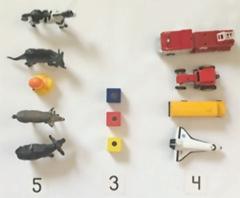
Topic B
Answer How Many Questions with Up to 5 Objects
Students integrate the elements of the number core while considering different ways and reasons to count. They learn three strategies to help them count accurately regardless of configuration: touch and count, move and count, and mark and count.
Topic C
Write Numerals and Create Sets of Up to 5 Objects
Students begin to write numerals and experience more complex counting situations, like counting sounds and words that can be heard but not seen. They count out objects to match a given number. They also count to find out whether they have enough of something.

Copyright © Great Minds PBC 2
Topic D Decompose Numbers
Students explore number relationships. This begins with the familiar context of sorting and then moves to story problems. Students begin to use number sentences like 5 is 2 and 3. These early experiences with problem solving set the stage for work with addition and subtraction concepts in modules 4 and 5.
Topic E
Answer How Many Questions with Up to 10 Objects
Topic E builds on the work of topic B as students apply number core concepts to sets of 6 to 10 objects. As the size of the group gets larger, tracking the count becomes more challenging. Students consider how to choose an accurate counting strategy.
Topic F Write Numerals and Create Sets of Up to 10 Objects
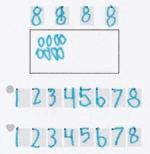
Topic F provides space to practice counting while students learn to write 6, 7, 8, 9, and 10. Students count things that happen over time, like a person’s jumps or the runs in a baseball game, and see that writing numbers is a good way to record and remember that information.
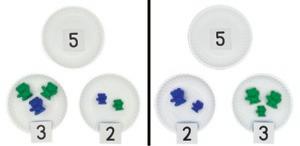
Topic G
Analyze the Count Sequence
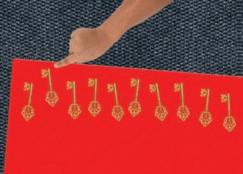
Students analyze the count sequence focusing on the ideas that each successive number is 1 more when counting forward and 1 less when counting backward. The number stairs model clearly illustrates these patterns.
10987654321
After This Module
Kindergarten Module 2
Students apply their ability to isolate and sort by attributes, including number, as they analyze and compare shapes in module 2. They count sides and corners as they name, compare, model, and compose shapes.
EUREKA MATH2 K ▸ M1 Copyright © Great Minds PBC 3
Answer How Many Questions with Up to 5 Objects
Conserve number regardless of the arrangement of objects.
Copyright © Great Minds PBC 4 Contents Counting and Cardinality Why . . . . . . . . . . . . . . . . . . . . . . . . . . . . . . . . . . . . . . . . . . 6 Achievement Descriptors: Overview . . . . . . . . . . . . . . . 10 Topic A . . . . . . . . . . . . . . . . . . . . . . . . . . . . . . . . . . . . . . . 13 Classify to Make Categories and Count Lesson 1 . . . . . . . . . . . . . . . . . . . . . . . . . . . . . . . . . . . . . . . . 16 Compare objects based on their attributes. Lesson 2 . . . . . . . . . . . . . . . . . . . . . . . . . . . . . . . . . . . . . . . . 24 Classify objects into two categories. Lesson 3 . . . . . . . . . . . . . . . . . . . . . . . . . . . . . . . . . . . . . . . 32 Classify objects into two categories and count. Lesson 4 . . . . . . . . . . . . . . . . . . . . . . . . . . . . . . . . . . . . . . . 44 Classify objects into three categories and count. Lesson 5 . . . . . . . . . . . . . . . . . . . . . . . . . . . . . . . . . . . . . . . 60 Classify objects into three categories, count, and match to a numeral. Topic B . . . . . . . . . . . . . . . . . . . . . . . . . . . . . . . . . . . . . . . . . . . . . . . 70
Lesson 6 . . . . . . . . . . . . . . . . . . . . . . . . . . . . . . . . . . . . . . . 74 Organize, count, and represent a collection of objects. Lesson 7 . . . . . . . . . . . . . . . . . . . . . . . . . . . . . . . . . . . . . . . . 86 Practice counting accurately. Lesson 8 . . . . . . . . . . . . . . . . . . . . . . . . . . . . . . . . . . . . . . . 94
Lesson 9 . . . . . . . . . . . . . . . . . . . . . . . . . . . . . . . . . . . . . . 104
Count sets in linear, array, and scattered configurations.
Topic C . . . . . . . . . . . . . . . . . . . . . . . . . . . . . . . . . . . . . . . . . . . . . . . 113 Write Numerals and Create Sets of Up to 5 Objects Lesson 10 . . . . . . . . . . . . . . . . . . . . . . . . . . . . . . . . . . . . . . 116 Count out a group of objects to match a numeral. Lesson 11 . . . . . . . . . . . . . . . . . . . . . . . . . . . . . . . . . . . . . . 124 Write numerals 1–3 to answer how many questions. Lesson 12 . . . . . . . . . . . . . . . . . . . . . . . . . . . . . . . . . . . . . . 134 Write numerals 4 and 5 to answer how many questions. Lesson 13 . . . . . . . . . . . . . . . . . . . . . . . . . . . . . . . . . . . . . . 144 Count out enough objects and write the numeral. Topic D . . . . . . . . . . . . . . . . . . . . . . . . . . . . . . . . . . . . . . . . . . . . . . 153 Decompose Numbers Lesson 14 . . . . . . . . . . . . . . . . . . . . . . . . . . . . . . . . . . . . . . 156 Understand the meaning of zero and write the numeral. Lesson 15 . . . . . . . . . . . . . . . . . . . . . . . . . . . . . . . . . . . . . . 166 Sort the same group of objects in more than one way and count. Lesson 16 . . . . . . . . . . . . . . . . . . . . . . . . . . . . . . . . . . . . . . 178 Decompose a set shown in a picture. Lesson 17 . . . . . . . . . . . . . . . . . . . . . . . . . . . . . . . . . . . . . . 188 Model story problems. Lesson 18 . . . . . . . . . . . . . . . . . . . . . . . . . . . . . . . . . . . . . . 200 Model story problems and identify the numeral referents.
Order numerals 1–10 and reason about an unknown number in the number sequence.
Analyze the Count Sequence
Lesson 29
Model the pattern of 1 more in the forward count sequence.
Lesson 30
Build number stairs to show the pattern of 1 more in the forward count sequence. Lesson
Model the pattern of 1 less in the backward count sequence.
Build number stairs to show the pattern of 1 less in the backward count sequence.
33
EUREKA MATH2 K ▸ M1 Copyright © Great Minds PBC 5 Topic E . . . . . . . . . . . . . . . . . . . . . . . . . . . . . . . . . . . . . . . . . . . . . . 210
to 10 Objects Lesson 19 . . . . . . . . . . . . . . . . . . . . . . . . . . . . . . . . . . . . . . 214 Organize, count, and represent a collection of objects. Lesson 20 . . . . . . . . . . . . . . . . . . . . . . . . . . . . . . . . . . . . . 224 Count objects in 5-group and array configurations and match to a numeral. Lesson 21 . . . . . . . . . . . . . . . . . . . . . . . . . . . . . . . . . . . . . . 236 Count sets in circular configurations and match to a numeral. Lesson 22 . . . . . . . . . . . . . . . . . . . . . . . . . . . . . . . . . . . . . 246 Count sets in scattered configurations and match to a numeral. Lesson 23 . . . . . . . . . . . . . . . . . . . . . . . . . . . . . . . . . . . . . 284 Conserve number regardless of the order in which objects are counted. Topic F . . . . . . . . . . . . . . . . . . . . . . . . . . . . . . . . . . . . . . . . . . . . . . 293 Write Numerals and Create Sets of Up to 10 Objects Lesson 24 . . . . . . . . . . . . . . . . . . . . . . . . . . . . . . . . . . . . . 296 Count out a group of objects to match a numeral. Lesson 25 . . . . . . . . . . . . . . . . . . . . . . . . . . . . . . . . . . . . . 304 Write numerals 6 and 7. Lesson 26 . . . . . . . . . . . . . . . . . . . . . . . . . . . . . . . . . . . . . 312 Write numeral 8. Lesson 27 . . . . . . . . . . . . . . . . . . . . . . . . . . . . . . . . . . . . . . 320
numerals
10. Lesson 28 . . . . . . . . . . . . . . . . . . . . . . . . . . . . . . . . . . . . . 330
Answer How Many Questions with Up
Write
9 and
Topic G . . . . . . . . . . . . . . . . . . . . . . . . . . . . . . . . . . . . . . . . . . . . . . 339
. . . . . . . . . . . . . . . . . . . . . . . . . . . . . . . . . . . . . . 342
. . . . . . . . . . . . . . . . . . . . . . . . . . . . . . . . . . . . . .
352
. . . . . . . . . . . . . . . . . . . . . . . . . . . . . . . . . . . . . . . 362
31
Lesson
. . . . . . . . . . . . . . . . . . . . . . . . . . . . . . . . . . . . . . 372
32
. . . . . . . . . . . . . . . . . . . . . . . . . . . . . . . . . . . . . . 382 Organize, count, and represent a collection of objects. Resources Observational Assessment Recording Sheet . . . . . . . . . . . . . . . . 390 Module Assessment . . . . . . . . . . . . . . . . . . . . . . . . . . . . . . . 392 Standards . . . . . . . . . . . . . . . . . . . . . . . . . . . . . . . . . . . . . . 398 Achievement Descriptors: Proficiency Indicators . . . . . . . . . . . . 400 Terminology . . . . . . . . . . . . . . . . . . . . . . . . . . . . . . . . . . . . 406 Math Past . . . . . . . . . . . . . . . . . . . . . . . . . . . . . . . . . . . . . . 408 Materials . . . . . . . . . . . . . . . . . . . . . . . . . . . . . . . . . . . . . . . 410 Works Cited . . . . . . . . . . . . . . . . . . . . . . . . . . . . . . . . . . . . . 416 Credits . . . . . . . . . . . . . . . . . . . . . . . . . . . . . . . . . . . . . . . . . 417 Acknowledgments . . . . . . . . . . . . . . . . . . . . . . . . . . . . . . . . 418
Lesson
Counting and Cardinality
What is the number core? How is it tied to counting?
In this module, children have sustained interaction with four core ideas for describing the number of objects in a group. These ideas are collectively referred to as the number core.
• The number word list—Students say numbers in the appropriate count sequence (1, 2, 3, …).
• One-to-one correspondence—When counting, students pair one object with one number word, being careful not to count any objects twice or skip any objects.
• Cardinality—Students say a number to tell how many are in a group. They may be able to tell how many by subitizing, counting, or matching to group of known quantity. When counting, students recognize that the last number said represents the number of objects in the group.
• Written numerals—Students read and write the symbols used to represent numbers. They also connect the written numeral with the number of objects in a set.


Students must integrate all aspects of the number core to count and use numbers fluently. The majority of kindergarten activities should involve three or more elements of the number core in conjunction. The number core components are not learned in isolation.
The number core plays a foundational role in work with number relations, operations, and place value understanding and is thus a critical start to the kindergarten year.
Students use one-to-one correspondence when they say one number word for each spider they touch.
Students show how many are in a set (cardinality) using written numerals.
Copyright © Great Minds PBC 6
Why
Why isn’t there a lesson for each number from 1 to 10?
Module 1 focuses on strategies rather than specific numbers. When students learn strategies for counting accurately, they are able to apply them to different numbers arranged in different configurations.
For instance, when counting in a circular configuration, the challenging part is identifying the starting and stopping points so that every object is counted once and only once. Once a student has learned a strategy for marking the start, that strategy can be useful in successfully counting any number of objects in a circular configuration. The same strategy for marking the start can also be used to count the sides and corners of shapes.
As early as possible, we want students to approach problem solving with a strategy that allows them to be accurate and efficient. When a lesson focuses on a single number, students go into the counting task anticipating the total. Counting tasks in which students do not already know the total but genuinely want to know the total open them to the process of choosing a strategy to solve a problem (MP1). With good questioning, students can begin to evaluate whether their chosen strategy is effective.
A focus on strategies rather than specific numbers means that the size of a set can be varied to challenge individual students. This approach creates accessibility and engagement for kindergartners with a range of counting experiences.


What is counting the math way? How does it affect later learning?
Fingers are familiar manipulatives that students have with them all day, every day, and if used intentionally, fingers can support conceptual understanding and problem solving throughout elementary school. Around the world, people use their fingers to represent numbers in many different ways. Depending on their cultural experiences, young children may begin counting on a thumb, pointer finger, pinkie, or even a section of a finger. Students learn to count the math way in module 1, starting with 1 on the left pinkie finger and continuing to 10 on the right pinkie finger.
EUREKA MATH2 K ▸ M1 Copyright © Great Minds PBC 7
The mathematical advantage of counting the math way is that students count from left to right without interruption, just as they do on the number path, and eventually, the number line. Students see and feel the quantity increase as they count forward. The steady increase in distance from the starting point is a physical and visual model for understanding the magnitude of a number.
Counting the math way has advantages for understanding number relationships that will be important in kindergarten and beyond.
• Unitizing. When students unitize, they make use of five as a whole instead of thinking of it as 5 individual pieces. The structure of our hands makes it easier for students to unitize 5 when they think about 6 as 5 and 1, 7 as 5 and 2, and so on. Unitizing is a key step to using Level 2 counting on strategies.














• Partners to 10. Fluency with partners to 10 is critical to Level 3 problem-solving strategies. When counting the math way, students can easily see that the raised fingers and the lowered fingers are partners to 10. Other ways of finger counting do not always keep the fingers representing each part next to one another.
• Embedded numbers. The ability to decompose a number into embedded parts is foundational to many Level 3 strategies. Showing parts within a total is easy when both parts are 5 or less. When modeling 2 + 3, a student can show one part on each hand. It is more challenging to see the parts when modeling 6 + 2. As fine motor skills develop, students can wiggle the fingers representing one part while holding the other part steady. Counting the math way creates consistency with how the embedded number looks inside the total.

K ▸ M1 EUREKA MATH2 Copyright © Great Minds PBC 8
105 94 83 72 61
This is a module about numbers to 10. Why do you suggest counting collections with as many as 25 objects?
Counting collections are rich tasks that allow students to explore numbers and engage with the mathematical practices. They are also authentic assessment opportunities for teachers.


The first counting collection, which occurs in lesson 6, is a diagnostic assessment as much as it is an opportunity to introduce counting strategies. Young children with regular access to high-quality math experiences may walk into kindergarten with the ability to organize, count, and represent sets of 50 or more objects. Providing larger counting collections gives those students a chance to share the full range of their abilities so teachers can differentiate instruction to meet their needs.
We suggest beginning with collections of between 5 and 25 objects for the following reasons:
• Research indicates that students may count farther when counting objects than they do when asked to rote count.1
• When students cross into the twenties, we see whether they can use the repeated pattern of number names in English (e.g., saying twenty-one instead of twenty-eleven).
• Young students are good at choosing a collection that matches up with their counting abilities when the collections have fewer than 25 objects. With larger collections, students can’t perceive the difference between collection sizes with enough accuracy to stay within a comfortable range.
• Experiencing success in early kindergarten activities is important to building students’ self-confidence and the sense that they are mathematicians.
The number of objects in a collection should increase in subsequent lessons (lessons 19 and 33) if any student shows mastery through 25. Try 40 or 50 objects and slowly increase the number until you find the spot where the student begins to need help with the number word list, or with organizing to maintain one-to-one correspondence.
EUREKA MATH2 K ▸ M1 Copyright © Great Minds PBC 9
1 Carpenter, Thomas P., Young Children’s Mathematics, p. 26
Achievement Descriptors: Overview
Counting and Cardinality
Achievement Descriptors (ADs) are standards-aligned descriptions that detail what students should know and be able to do based on the instruction. ADs are written by using portions of various standards to form a clear, concise description of the work covered in each module.
Each module has its own set of ADs, and the number of ADs varies by module. Taken together, the sets of module-level ADs describe what students should accomplish by the end of the year.
ADs and their proficiency indicators support teachers with interpreting student work on
• informal classroom observations (recording sheet provided in the module resources),
• data from other lesson-embedded formative assessments, and
• Module Assessments.
This module contains the 10 ADs listed.
K.Mod1.AD1
Count to 10.
K.Mod1.AD2
Write numbers from 0 to 10.
K.Mod1.AD3
Represent a group of objects with a written numeral 0–10.
K.CC.A.1
K.Mod1.AD4
Say one number name with each object when counting up to 10 objects.
K.CC.B.4.a
K.Mod1.AD5
Use the last number of a count to tell how many regardless of arrangement or order counted.
K.CC.B.4.b
K.Mod1.AD6
Say how many without recounting when objects are rearranged.
K.CC.B.4.b
Copyright © Great Minds PBC 10
K.CC.A.3
K.CC.A.3
390 Copyright © Great Minds PBC This page may be reproduced for classroom use only. Observational Assessment Recording Sheet Student Name Grade K Module Counting and Cardinality Achievement Descriptors Dates and Details of Observations K.Mod1.AD1 Count to 10. K.Mod1.AD2 Write numbers from to 10. K.Mod1.AD3 Represent a group of objects with a written numeral 0–10. K.Mod1.AD4 Say one number name with each object when counting up to 10 objects. K.Mod1.AD5 Use the last number of count to tell how many regardless of arrangement or order counted. K.Mod1.AD6 Say how many without recounting when objects are rearranged. K.Mod1.AD7 Recognize that each successive number one more when counting within 10. K.Mod1.AD8 Count to answer how many questions about as many as 10 things arranged in a line, rectangular array, a circle, or scattered configuration. K.Mod1.AD9 Count out given number of 1–10 objects from larger group. K.Mod1.AD10 Sort objects into categories. Notes PP Partially Proficient P Proficient HP Highly Proficient
K.Mod1.AD7
Recognize that each successive number is one more when counting within 10.
K.CC.B.4.c
K.Mod1.AD10
Sort objects into categories.
K.Mod1.AD8
Count to answer how many questions about as many as 10 things arranged in a line, a rectangular array, a circle, or a scattered configuration.
K.Mod1.AD9
Count out a given number of 1–10 objects from a larger group.
The first page of each lesson identifies the ADs aligned with that lesson. Each AD may have up to three indicators, each aligned to a proficiency category (i.e., Partially Proficient, Proficient, Highly Proficient). While every AD has an indicator to describe Proficient performance, only select ADs have an indicator for Partially Proficient and/or Highly Proficient performance.
An example of one of these ADs, along with its proficiency indicators, is shown here for reference. The complete set of this module’s ADs with proficiency indicators can be found in the Achievement Descriptors: Proficiency Indicators resource.
EUREKA MATH2 K ▸ M1 Copyright © Great Minds PBC 11
K.CC.B.5
K.CC.B.5
K.MD.B.3
K.Mod1.AD9 Count out a given number of 1–10 objects from a larger group.
RELATED CCSSM
ADs have the following parts:
K.CC.B.5 Count to answer “how many?” questions about as many as 20 things arranged in a line, a rectangular array, or a circle, or as many as 10 things in a scattered configuration; given a number from 1–20, count out that many objects.
• AD Code: The code indicates the grade level and the module number and then lists the ADs in no particular order. For example, the first AD for grade K module 1 is coded as K.Mod1.AD1.
Partially Proficient Proficient
Highly Proficient
• AD Language: The language is crafted from standards and concisely describes what will be assessed.
Count out a given number of 1–5 objects from a larger group.
Count out a given number of 6–10 objects from a larger group.
• AD Indicators: The indicators describe the precise expectations of the AD for the given proficiency category.
Circle 3 paper clips.
Circle 6 balls.
• Related Standard: This identifies the standard or parts of standards from the Common Core State Standards that the AD addresses.
AD Code
Grade.Module.AD#
K.Mod1.AD10 Sort objects into categories.
RELATED CCSSM
AD Language
K.MD.B.3 Classify objects into given categories; count the numbers of objects in each category and sort the categories by count. 3 3Limit category counts to be less than or equal to 10.
Partially Proficient Proficient
Identify whether objects are the same or different. Are these shapes exactly the same?
Sort objects into categories when an attribute is given. Sort the objects by color.
Highly Proficient
Sort objects into categories when an attribute is not given. Sort the objects.
Related Standard
Copyright © Great Minds PBC
AD Indicators
K ▸ M1 EUREKA MATH2
PBC 12
Copyright © Great Minds
EUREKA MATH2 K ▸ M1
405
Topic A Classify to Make Categories and Count
Topic A capitalizes on the energy and excitement of young students as they enter kindergarten by offering playful, active experiences with mathematics. The lessons provide the time students need to explore the tools and procedures of math during the first days of school.
Two fundamental math concepts intertwine in this topic: classification and the number core. For kindergarten students, classification involves identifying the attributes of an object, using attributes to sort objects, and discussing sorting strategies and rules: This bead goes in the red group. I’m sorting by color. These basic concepts of classification are foundational to working with geometry, data, and operations during the kindergarten year and beyond.
Sorting objects into groups creates a natural context for counting: How many blue beads are in this group? How many red beads are in that group? Sorting contexts provide a meaningful way to introduce four core ideas about counting, collectively referred to as the number core:


• The number word list (the counting sequence—i.e., 1, 2, 3, …)
• One-to-one correspondence (one object paired with one number word)
• Cardinality (how many in a set)
• Written numerals
Throughout module 1, students have experiences that help them make critical connections between these four understandings. In module 3, students extend this learning by comparing the count in each group: Which group has more beads?
Students first sort objects into groups based on a single attribute.
Then they apply the number core to count each group.
Copyright © Great Minds PBC 13
Progression of Lessons
Lesson 1
Compare objects based on their attributes.
Lesson 2
Classify objects into two categories.
Lesson 3
Classify objects into two categories and count.
The apples are the same color but different sizes.


I sorted by color.
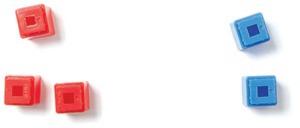
I sorted by size. There are 5 small rocks and 3 big rocks.
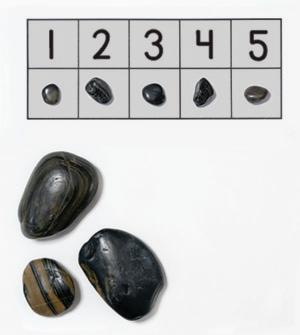
Copyright © Great Minds PBC 14 K ▸ M1 ▸ TA EUREKA MATH2
Lesson 4
Classify objects into three categories and count.
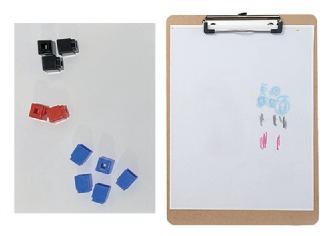

Lesson 5
Classify objects into three categories, count, and match to a numeral.
I sorted by color. I drew 3 black, 2 red, and 5 blue.
I sorted by name. I put a number next to each group.
EUREKA MATH2 K ▸ M1 ▸ TA Copyright © Great Minds PBC 15
Compare objects based on their attributes.
Lesson at a Glance
Observational Assessment Recording Sheet
In this lesson, students consider multiple attributes to compare objects. If all the attributes are the same, the objects are exactly the same. If some attributes are the same but some are different, students use the same but … to describe the similarities and differences. Attention to attributes is foundational to sorting throughout this topic.
Key Question
• What are some ways that things can be the same? Achievement
K.Mod1.AD10 Sort objects into categories. (K.MD.B.3)
Copyright
Great Minds
1
Descriptor
LESSON 1
©
PBC 390 Copyright © Great Minds PBC This page may be reproduced for classroom use only.
Student Name Grade K Module 1 Counting and Cardinality Achievement Descriptors Dates and Details of Observations K.Mod1.AD1 Count to 10. K.Mod1.AD2 Write numbers from 0 to 10. K.Mod1.AD3 Represent a group of objects with a written numeral 0–10. K.Mod1.AD4 Say one number name with each object when counting up to 10 objects. K.Mod1.AD5 Use the last number of a count to tell how many regardless of arrangement or order counted. K.Mod1.AD6 Say how many without recounting when objects are rearranged. K.Mod1.AD7 Recognize that each successive number is one more when counting within 10. K.Mod1.AD8 Count to answer how many questions about as many as 10 things arranged in a line, a rectangular array, a circle, or a scattered configuration. K.Mod1.AD9 Count out a given number of 1–10 objects from a larger group. K.Mod1.AD10 Sort objects into categories. Notes PP Partially Proficient P Proficient HP Highly Proficient
Agenda Materials
Fluency 10 min
Launch 10 min
Learn 20 min
• Exactly the Same or the Same But …
• Problem Set
Land 10 min
Teacher
• Right-hand number glove
• Computer or device*
• Projection device*
• Teacher edition*
Students
• Two-Hands Mat (in the student book)
• Two-color beans (5)
• Resealable plastic bag
* These materials are only listed in lesson 1. Prepare these materials for every lesson in this module.
Lesson Preparation
• Consider how to incorporate routines and procedures into the lesson. Extra time has been allotted to each component of the lesson to make room for these routines and procedures.
• Prepare bags of 5 two-color beans for each student. Save the bags of beans for use in later lessons.
• Create number gloves. Start with the right-hand glove. Write numbers on the fingertips, beginning with 1 on the pinkie finger and ending with 5 on the thumb. Continue with the left-hand glove, beginning with 6 on the thumb and ending with 10 on the pinkie finger. Save the gloves for use in later lessons.
• Consider tearing out the Two-Hands Mat and placing it in a personal whiteboard. The Two-Hands Mat will be used many times throughout the module.
• Create two-color beans by spraypainting one side of the beans red.
Copyright © Great Minds PBC 17 EUREKA MATH2 K ▸ M1 ▸ TA ▸ Lesson 1
Fluency
Counting with Movement to 10
Students count with body movements to develop fluency with number names and one-to-one correspondence.
Let’s clap 5 times and count our claps. Ready?
Count and clap from 1 to 5 slowly at first, emphasizing that one number is said for each clap. Repeat until most students are clapping, counting, or ideally, clapping and counting.
Repeat the process, this time stomping and counting to 5.
Now let’s clap 10 times and count our claps. Ready?
Count and clap from 1 to 10 along with the students.
Repeat the process, this time stomping and counting to 10.
Counting on the Number Glove Within 3
Materials—T: Right-hand number glove
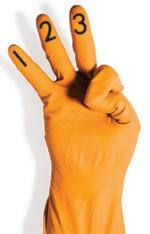
Students count on the number glove to develop numeral recognition and familiarity with counting the math way.
Watch my number glove and count out loud. Ready?
Begin with a closed fist, and then show the pinkie finger, followed by the ring finger, and then the middle finger. 1, 2, 3
Stay here at 3. Let’s count back down to 1. Ready?
Hold your 3 fingers up, and then put down the middle finger and then the ring finger. 3, 2, 1
UDL: Engagement
Adjust Counting with Movement to 10 to engage as many students as possible. Consider their physical abilities, cultural background, and interests when choosing movements. The following is a small sample of movements that can be easily counted:
• blinks
• head nods
• drumbeats
• frog hops
• basketball dribbles
10 10 20 10
K ▸ M1 ▸ TA ▸ Lesson 1 EUREKA MATH2 Copyright © Great Minds PBC 18
Number glove viewed from the students’ perspective
Offer more practice counting from 1 to 3 and back down to 1. Now you’re ready for something harder! This time we’ll count up and down, like a wave. Watch my number glove and count out loud.
Use the number glove to show the following sequence while students count aloud.
Teacher Note
Take care not to count along with students. Students may learn to mimic the teacher rather than focus on number order.
Control the pace of the count with your hands. Remember to listen to student responses, and be mindful of errors, hesitation, and lack of full-class participation. If needed, adjust the tempo or sequence of numbers.
Beans and Hands Mat
Materials—S: Two-Hands Mat, two-color beans
Students learn routines and procedures to prepare for distribution, care, and collection of materials.
• Distribute materials: Establish an efficient procedure for distributing the beans and mats. Teach and practice the procedure. Anticipate problems before they occur. Stop to correct and troubleshoot immediately.

• Care of materials: Interactively model storage and appropriate handling of beans.
• Freely explore materials: Allow students time to inspect, handle, talk about, and possibly count the materials without instructional goals.
• Collect materials: Reverse the distribution process.
1 2 3 2 1 2 1 2 3 2 3 2 3
EUREKA MATH2 K ▸ M1 ▸ TA ▸ Lesson 1 Copyright © Great Minds PBC 19
Launch
Students identify attributes in a set of pictures and isolate one attribute to select what doesn’t belong.
Display the set of pictures for the Which One Doesn’t Belong? routine.
With your eyes, look at the picture that doesn’t belong. Think about which one doesn’t go with the other pictures. Inside your head, think about why that picture doesn’t belong with the other pictures. What is different about that picture?
Establish routines that allow time for all students to formulate their own ideas. After sufficient think time, point to the picture of the wheel.
If you think the wheel doesn’t belong with the rest of the pictures, stand up.
Gather the standing students around you and whisper to them, asking why they think the wheel doesn’t belong. Elicit as many reasons as you can in an efficient way. Be sure everyone in the group whispers. Have students return to their seats. Summarize the small group’s reasoning to the whole group.
Our friends said the wheel doesn’t belong with the other pictures because it isn’t orange. Repeat these steps for each of the pictures that students choose.
• Color – The wheel doesn’t belong because it’s not orange.
• Size – The basketball doesn’t belong because it’s smaller than the others.
• Shape – The hat doesn’t belong because it’s not round.
• Use – The orange doesn’t belong because you can eat it and you can’t eat the other things.
Transition to the next segment by framing the work. You were good at using things like color and size to tell about objects. Today, we will use words to compare more things.
Teacher Note
In the first days of school, it is important to practice management routines that allow for maximum student learning. Two examples are written in Launch.
Beginning sentences with quiet reminders like “With your eyes” or “Inside your head” fosters think time for all students.
Whispering in a group will engage those not in the group because they will inherently try to listen to the “secret” being discussed in the group.
Language Support
Consider using strategic, flexible pairings throughout the module based on students’ mathematical and English language proficiency.
• Pair students who have different levels of mathematical proficiency.
• Pair students who have different levels of English language proficiency.
As applicable, complement any of these options by pairing students who speak the same native language.
10 10 20 10
K ▸ M1 ▸ TA ▸ Lesson 1 EUREKA MATH2 Copyright © Great Minds PBC 20
Learn
Exactly the Same or the Same But …
Students use attributes to establish whether two objects are exactly the same or the same but a little different.
Display the picture of the two ducks.
Look at the two ducks. Are they the same? How do you know they are the same?


Yes. They are both yellow. They are the same size.
Everything about them is the same. We can say they are exactly the same.
Show the picture of the apples.
Look at the two apples. Are they exactly the same? No.
What is the same about both apples? Turn and talk to your neighbor about the things that are the same about both apples.


They are both red. They are both round.
Promoting the Standards for Mathematical Practice
Students attend to precision (MP6) when they use the phrases exactly the same and the same but … to describe two objects. They precisely communicate common attributes among the objects rather than simply describing them as the same or different.
Observational Assessment
Listen to student responses during turn and talks. Can students describe the attributes that are the same and different?
10 10 20 10
EUREKA MATH2 K ▸ M1 ▸ TA ▸ Lesson 1 Copyright © Great Minds PBC 21
What’s not the same? What’s different about them? Turn and talk to your neighbor about how the apples are different. One is big and one is small.
They are the same because they are both red, round apples, but they are different because one is big and one is small. We can say they have the same name and are the same color and shape, but they are different sizes.

Repeat with each picture: the glasses of juice, the dice, and the dogs. To support students, summarize their thoughts by using a repetitive sentence structure.

• Everything about them is the same. They are exactly the same.
• They are the same because but different because .
• They are the same but different .
Problem Set
Problem Sets are normally set aside for students to work independently on the day’s objective. There is no independent practice for lesson 1. Use this time to establish transitions and routines so that, on subsequent days, students move around the classroom and handle materials, such as the student book, efficiently.
Providing opportunities for students to practice and show what they have learned through independent in-class work is an integral part of A Story of Units®. In kindergarten, that practice may take the form of hands-on experiences, games, or written work.
Gradual introduction of Problem Sets builds kindergarten students’ capacity to represent their work through drawing and writing. Problem Sets are not part of every kindergarten lesson.

Teacher Note
The images are sequenced to first establish the meaning of same and different and then challenge students to consider various attributes that can be compared.
The last pair may be particularly tricky because the same dog is in different positions. Why introduce this complexity? The idea that an object keeps its name regardless of its position or orientation will be important in module 2 when students consider the attributes of shapes. The triangles below are the same shape but in different positions.
Language Support
Young children are learning to produce complex sentences independently. Revoicing student responses by using a repetitive sentence structure provides a language model that students can emulate.
Students may use two simple sentences instead. “It’s the same dog. What’s different is one shows the dog sitting and the other shows the dog lying down.”


K ▸ M1 ▸ TA ▸ Lesson 1 EUREKA MATH2 Copyright © Great Minds PBC 22
Land
Debrief 10 min
Objective: Compare objects based on their attributes.
Display the set of pictures from Launch.
Which pictures are the same but a little bit different? The orange and the wheel are round, but you can’t eat a wheel.
The orange, the basketball, and the hat are the same because they are all orange but different because they are all different things.
I heard you say that the orange, the basketball, and the hat were the same because they are all orange. They are all the same …
Color
What are some other ways that things can be the same?
Size, name, shape, number
10 20 10 EUREKA MATH2 K ▸ M1 ▸ TA ▸ Lesson 1 Copyright © Great Minds PBC 23







































